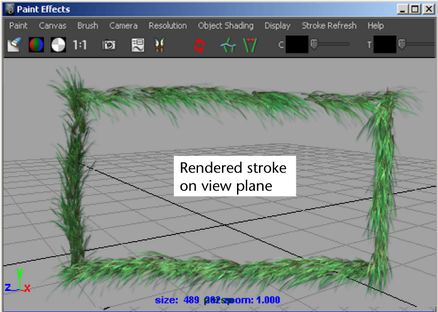The view plane is the plane ortho-normal to the camera. You can think of painting on the view plane as painting on a sheet of glass that is facing the camera and fixed to it. When you change the view (for example, when you tumble), the view plane changes (the sheet of glass moves with the camera).
You can only paint on the view plane in the scene painting view—not the scene view. When you paint on the view plane in the scene painting view, each stroke renders on the view plane, as you would expect. However, the wireframe representation of each stroke displays between 0 and 1 in world space on the XY plane (near the origin). Although the wireframe representation of the strokes appear to overlap in this area, the rendered strokes display where you painted them.


Painting on the view plane while in the scene view gives unexpected results. Use the Paint Effects panel to paint on the view plane instead.
You can open the Paint Effects panel as a separate window by selecting Window > Paint Effects.
 ). For information on modifying stroke settings, see Define default stroke settings.
). For information on modifying stroke settings, see Define default stroke settings.
You can use hotkeys on the canvas to interactively change the Global Scale (set ModifyUpperRadius, default hotkey, b), the Brush Width only (set ModifyLowerRadius), and Stroke Offset (set ModifyDisplacement, default hotkey, m) under Brush Tools in the Hotkey Editor. For information on other Paint Effects hotkeys, see Use default Paint Effects hotkeys.
For information on working in the scene painting view, see Automatically paint multiple strokes on a surface.
 Except where otherwise noted, this work is licensed under a Creative Commons Attribution-NonCommercial-ShareAlike 3.0 Unported License
Except where otherwise noted, this work is licensed under a Creative Commons Attribution-NonCommercial-ShareAlike 3.0 Unported License